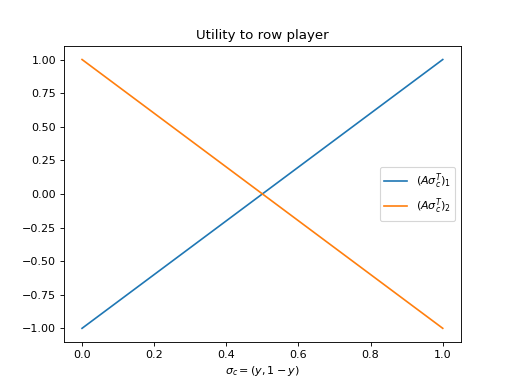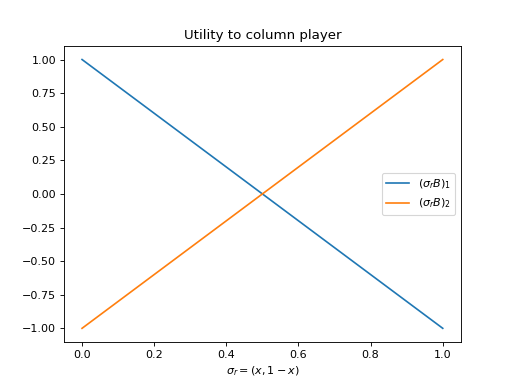Best responses¶
Motivating example: Best Responses in Matching Pennies¶
Considering the game Matching Pennies:
If the row player knows that the column player is playing the strategy \(\sigma_c=(0, 1)\) the utility of the row player is maximised by playing \(\sigma_r=(0, 1)\).
In this case \(\sigma_r\) is referred to as a best response to \(\sigma_c\).
Alternatively, if the column player knows that the row player is playing the strategy \(\sigma_r=(0, 1)\) the column player’s best response is \(\sigma_c=(1, 0)\).
Definition of a best response in a normal form game¶
In a two player game \((A,B)\in{\mathbb{R}^{m\times n}}^2\) a strategy \(\sigma_r^*\) of the row player is a best response to a column players’ strategy \(\sigma_c\) if and only if:
Where \(\mathcal{S}_1\) denotes the space of all strategies for the first player.
Similarly a mixed strategy \(\sigma_c^*\) of the column player is a best response to a row players’ strategy \(\sigma_r\) if and only if:
Question
For the Prisoners Dilemma:
What is the row player’s best response to either of the actions of the column player?
Answer
Recalling that \(A\) is given by:
Against the first action of the column player the best response is to choose the second action which gives a utility of 5. This can be expressed as:
Against the second action of the column player the best response is to choose the second action which gives a utility of 1. This can be expressed as:
The row player’s best response to either of the actions of the column player is \(\sigma_r^*=(0,1)\). This can be expressed as:
Definition of a degenerate game¶
A two player game is called non degenerate if no mixed strategy of support size \(k\) has more than \(k\) pure best responses.
Question
Show that the following game is degenerate:
Answer
The third column has two pure best responses.
Generic best responses in 2 by 2 games¶
In two player normal form games with \(|A_1|=|A_2|=2\): a 2 by 2 game, the utility of a row player playing \(\sigma_r=(x, 1 - x)\) against a strategy \(\sigma_c = (y, 1 - y)\) is linear in \(x\):
where:
This observation allows us to obtain the best response \(\sigma_r^*\) against any \(\sigma_c = (y, 1 - y)\).
For example, consider Matching Pennies. Below is a plot of \(u_r(\sigma_r, \sigma_c)\) as a function of \(y\) for \(\sigma_r \in \{(1, 0), (0, 1)\}\).
(Source code, png, hires.png, pdf)

Given that the utilities in both cases are linear, the best response to any value of \(y \ne 1/2\) is either \((1, 0)\) or \((0, 1)\). The best response \(\sigma_r^*\) is given by:
Question
For the Matching Pennies game:
What is the column player’s best response as a function of \(x\) where \(\sigma_r=(x, 1 - x)\).
Answer
Recalling that \(B\) is given by:
This gives:
Here is a plot of the utilities:
(Source code, png, hires.png, pdf)

The best response is given by:
General condition for a best response¶
In a two player game \((A,B)\in{\mathbb{R}^{m\times n}}^2\) a strategy \(\sigma_r^*\) of the row player is a best response to a column players’ strategy \(\sigma_c\) if and only if:
Proof¶
\((A\sigma_c^T)_i\) is the utility of the row player when they play their \(i^{\text{th}}\) action. Thus:
Let \(u=\max_{k}(A\sigma_c^T)_k\) giving:
We know that \(u - (A\sigma_c^T)_i\geq 0\), thus the largest \(\sigma_rA\sigma_c^T\) can be is \(u\) which occurs if and only if \({\sigma_r}_i > 0 \Rightarrow (A\sigma_c^T)_i = u\) as required.
Question
For the Rock Paper Scissors game:
Which of the following pairs of strategies are best responses to each other:
\(\sigma_r=(0, 0, 1) \text{ and } \sigma_c=(0, 1/2, 1/2)\)
\(\sigma_r=(1/3, 1/3, 1/3) \text{ and } \sigma_c=(0, 1/2, 1/2)\)
\(\sigma_r=(1/3, 1/3, 1/3) \text{ and } \sigma_c=(1/3, 1/3, 1/3)\)
Answer
Recalling that \(A\) and \(B\) are given by:
We can apply the best response condition to each pairs of strategies:
\(A\sigma_c^T = \begin{pmatrix}0\\ -1/2\\ 1/2\\\end{pmatrix}\). \(\text{max}(A\sigma_c^T)=1/2\). The only \(i\) for which \({\sigma_r}_i > 0\) is \(i=3\) and \((A\sigma_c^T)_3=\text{max}(A\sigma_c^T)\) thus \(\sigma_r\) is a best response to \(\sigma_c\). \(\sigma_rB = (1, -1, 0)\). \(\text{max}(\sigma_rB)=1\). The values of \(i\) for which \({\sigma_c}_i > 0\) are \(i=2\) and \(i=3\) but \((\sigma_r B)_2 \ne \text{max}(\sigma_r B)\) thus \(\sigma_c\) is not a best response to \(\sigma_r\).
\(A\sigma_c^T = \begin{pmatrix}0\\ -1/2\\ 1/2\\\end{pmatrix}\). \(\text{max}(A\sigma_c^T)=1/2\). The values of \(i\) for which \({\sigma_r}_i > 0\) are \(i=1\), \(i=2\) and \(i=3\) however, \((A\sigma_c^T)_2 \ne \text{max}(A\sigma_c^T)\) thus \(\sigma_r\) is not a best response to \(\sigma_c\). \(\sigma_rB = (0, 0, 0)\). \(\text{max}(\sigma_rB)=0\). The values of \(i\) for which \({\sigma_c}_i > 0\) are \(i=2\) and \(i=3\) and \((\sigma_r B)_2 = (\sigma_r B)_3= \text{max}(\sigma_r B)\) thus \(\sigma_c\) is a best response to \(\sigma_r\).
\(A\sigma_c^T = \begin{pmatrix}0\\ 0\\ 0\\\end{pmatrix}\). \(\text{max}(A\sigma_c^T)=0\). The values of \(i\) for which \({\sigma_r}_i > 0\) are \(i=1\), \(i=2\) and \(i=3\) and \((A\sigma_c^T)_1=(A\sigma_c^T)_2 = (A\sigma_c^T)_3 =\text{max}(A\sigma_c^T)\) thus \(\sigma_r\) is a best response to \(\sigma_c\). \(\sigma_rB = (0, 0, 0)\). \(\text{max}(\sigma_rB)=0\). The values of \(i\) for which \({\sigma_c}_i > 0\) are \(i=1\), \(i=2\) and \(i=3\) and \((\sigma_r B)_1 =(\sigma_r B)_2 = (\sigma_r B)_3= \text{max}(\sigma_r B)\) thus \(\sigma_c\) is a best response to \(\sigma_r\).
Definition of Nash equilibrium¶
In a two player game \((A, B)\in {\mathbb{R}^{m \times n}} ^ 2\), \((\sigma_r, \sigma_c)\) is a Nash equilibria if \(\sigma_r\) is a best response to \(\sigma_c\) and \(\sigma_c\) is a best response to \(\sigma_r\).
Exercises¶
For the following games identify the best responses that are strategies with support size 1 (i.e. strategies that just play a single action).
\[\begin{split}A = \begin{pmatrix} 2 & 1\\ 1 & 1\end{pmatrix} \qquad B = \begin{pmatrix} 1 & 1\\ 1 & 3\end{pmatrix}\end{split}\]\[\begin{split}A = \begin{pmatrix} 2 & 1 & 3 & 17\\ 27 & 3 & 1 & 1\\ 4 & 6 & 7 & 18 \end{pmatrix} \qquad B = \begin{pmatrix} 11 & 9 & 10 & 22\\ 0 & 1 & 1 & 0\\ 2 & 10 & 12 & 0 \end{pmatrix}\end{split}\]\[\begin{split}A = \begin{pmatrix} 3 & 3 & 2 \\ 2 & 1 & 3 \end{pmatrix} \qquad B = \begin{pmatrix} 2 & 1 & 3 \\ 2 & 3 & 2 \end{pmatrix}\end{split}\]\[\begin{split}A = \begin{pmatrix} 3 & -1\\ 2 & 7\end{pmatrix} \qquad B = \begin{pmatrix} -3 & 1\\ 1 & -6\end{pmatrix}\end{split}\]Represent the following game in normal form:
Assume two neighbouring countries have at their disposal very destructive armies. If both countries attack each other the countries’ civilian population will suffer 10 thousand casualties. If one country attacks whilst the other remains peaceful, the peaceful country will lose 15 thousand casualties but would also retaliate causing the offensive country 13 thousand casualties. If both countries remain peaceful then there are no casualties.
Clearly state the players and strategy sets.
Plot the utilities to both countries assuming that they play a mixed strategy while the other country remains peaceful.
Plot the utilities to both countries assuming that they play a mixed strategy while the other country attacks.
Obtain the best responses of each player.
Construct a degenerate \(3\times 3\) game.
Using Nashpy¶
See Check if a strategy is a best response for guidance of how to use Nashpy to check if a strategy is a best response.